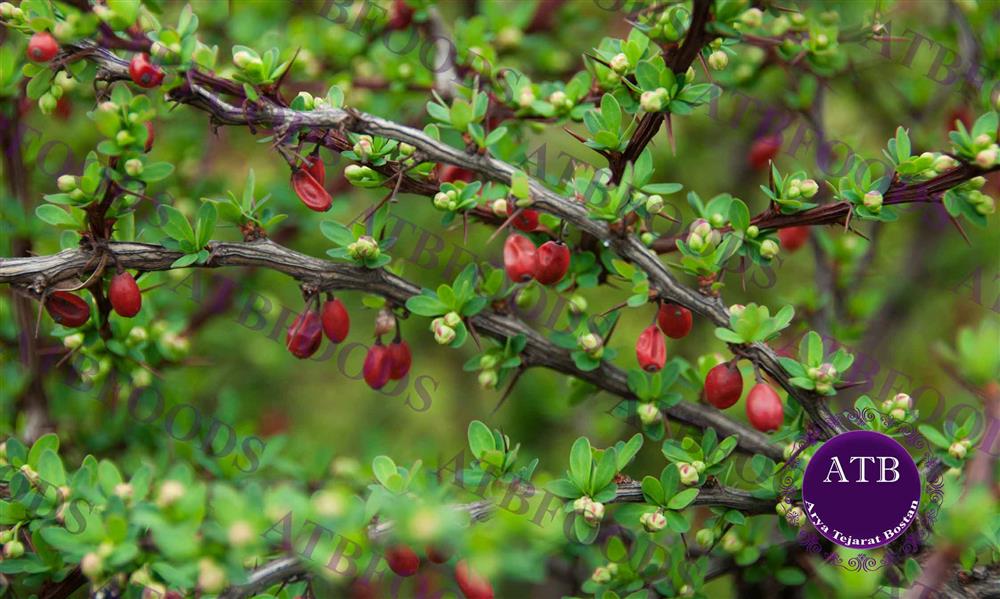Japanese Barberry (Berberis thunbergii var. atropurpurea):
A perennial shrub with a height of 0.9 to 1.8 meters, singular branches, long and arched with a dense and soft texture. The shrub is rounded, with slightly more spread than the length of its branches. In summer, the branches are red or purplish, turning red in autumn, and the stem growth pattern is zigzag. The thorns, around 25.1 centimeters long, are red at the nodes. The leaves are alternate, spatula-like or egg-shaped (broadly free at the tip), red or reddish-purple, and this barberry prefers acidic or neutral soils.
The flowers are abundant, yellowish-red, appearing in March and April. The fruit is in the form of berries, red and shiny, ripening in May, remaining attractive and present throughout the winter

Distribution of Barberry:
It is cultivated as an ornamental and resilient plant in dry conditions in many areas. Its thorny stems spread widely on the ground and can help control litter and debris in urban areas. It propagates easily through both vegetative growth and seeds. Numerous varieties have been developed, including:
- Bagatella (dwarf)
- Cherry Bomb
- Crimson Pigmy (dwarf, resistant to poor soils with entirely red branches)
- Golden Ring
- Red Chief
- Rose Glow (red and yellowish leaves, resistant to poor soils)
- Royal Bergandi (dwarf)
- Variegat (green leaves)
- Thornless (without thorns) - Hybridizing this variety with seedless barberry can be of interest to create thornless barberries.
- Sparkle (dark green branches, but orange-red in autumn)
Ornamental Barberries and Their Uses in Green Spaces
Ornamental barberries can be categorized into three groups: evergreen, semi-evergreen, and deciduous. Evergreen and semi-evergreen shrubs, with features such as clusters of yellow to orange flowers, red to blue-purple fruits, and beautiful color changes in leaves and branches in autumn, are used in designing green spaces, from rocky gardens to park perimeters, either individually or in small groups. Ornamental barberries exhibit a wide variety in leaf and fruit colors. Most evergreen barberries have Asian origins, are highly resistant, and can easily grow in sunlight or partial shade in well-drained soils. These species typically have egg-shaped leaves and red berries. Evergreen barberries have leathery, often serrated, card-like leaves with blue, black, or purple fruits. They are mainly of Asian origin, with a small number also found in South America.
Berberis darwinii and Berberis stenophylla are among the most beautiful evergreen shrubs that are cultivated. American barberry is native to Northeastern America. Japanese barberry, often planted as an ornamental shrub, has several varieties with red or yellow short branches and leaves that are used in green space design. The Japanese barberry, the most commonly used barberry in green space design worldwide, is known for its good adaptability. Up to 1981, 16 different beautiful varieties were introduced, classified into two groups based on leaf color: red (purplish) leaves named atropurpurea and green leaves.
There are approximately 500 species of barberry in the Berberidaceae family. Barberries are found mostly in Europe, North Africa, the Middle East, and Central Asia. Some refer to a variety of Oregon grape that belongs to the Berberis family as barberry, European barberry, or Berberis. The roots, bark, and fruit of the barberry tree have therapeutic uses. Barberry fruit is a rich source of vitamin C, with a very tart and acrid taste. Many people recognize the barberry shrub as the Japanese barberry shrub. This shrub is 90 to 180 centimeters tall and about 2 meters wide, with fruits that endure through winter. Barberry fruit, stem, and root contain beneficial alkaloids, the most famous of which is berberine. Laboratory studies and studies on animals show that berberine has anti-seizure, antimicrobial, anti-inflammatory, and sleep-inducing properties, and it helps lower blood pressure. Berberine also has a positive effect on strengthening the immune system and is effective in improving a wide range of infections and diseases.
The largest barberry producer in the world
Although there are many types of barberry in the world today, there is no doubt that Iranian barberry is the most different of them.
Iran is the leader in the world with the production of 95% of barberry. It also has a better taste and quality than other competitors.
In Iran, the best barberry is sent in bulk by Arya Tejarat Bostan company to all over the world including Australia, South Africa, Europe and Canada.